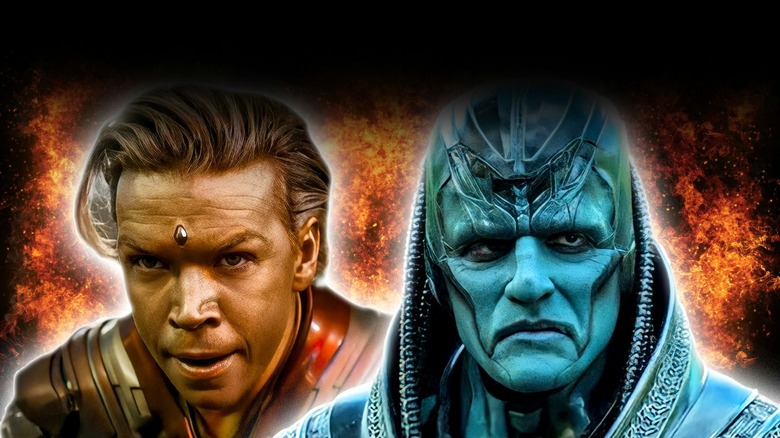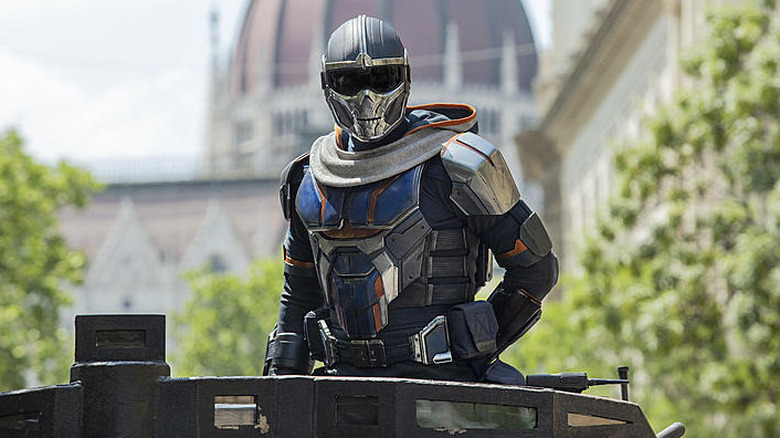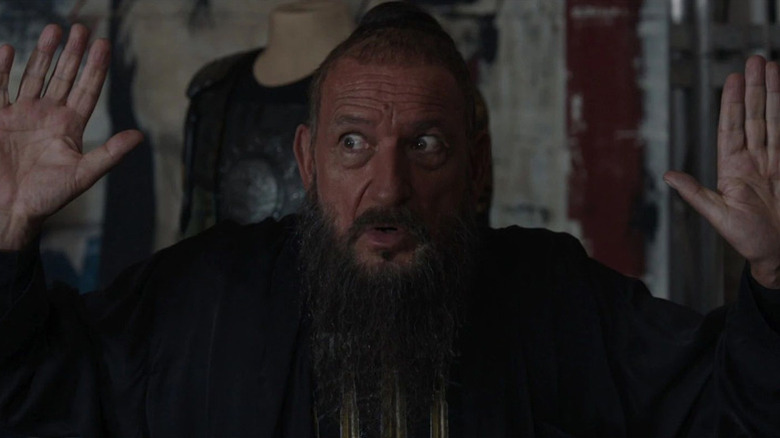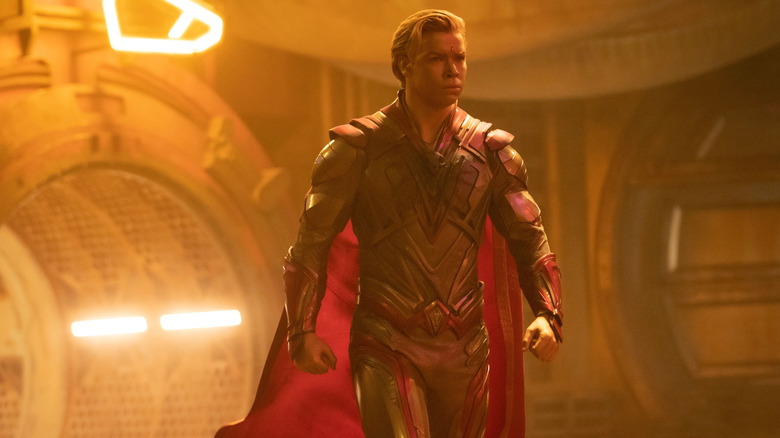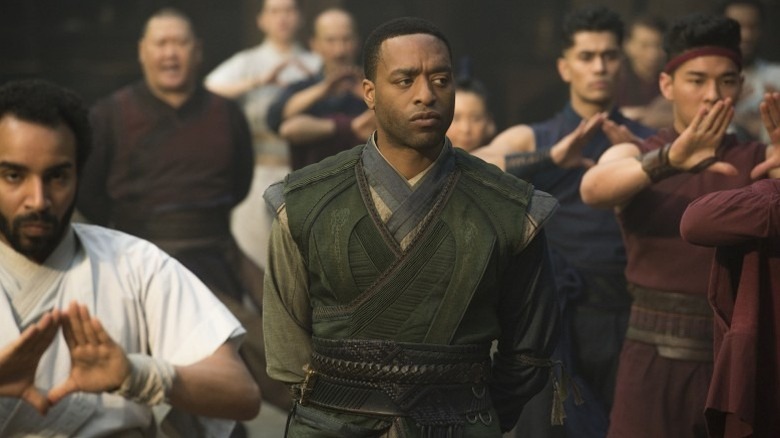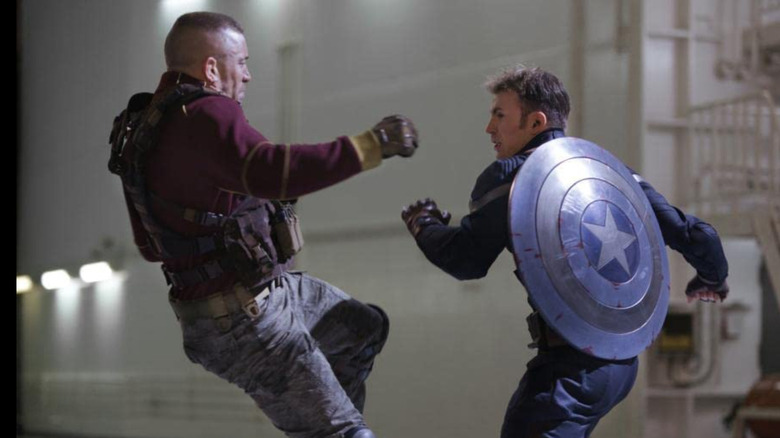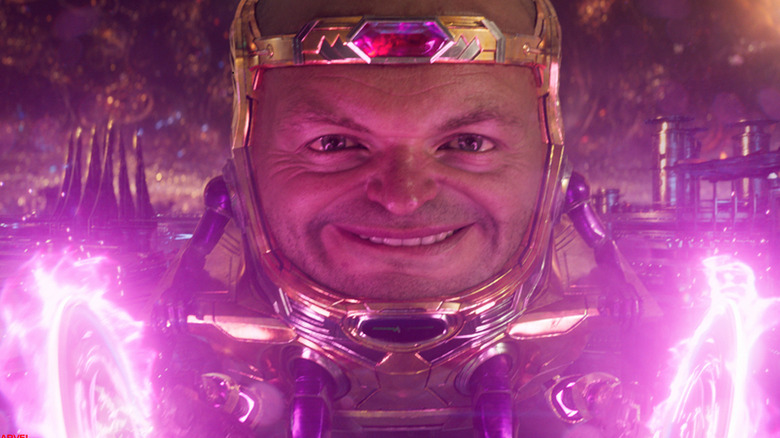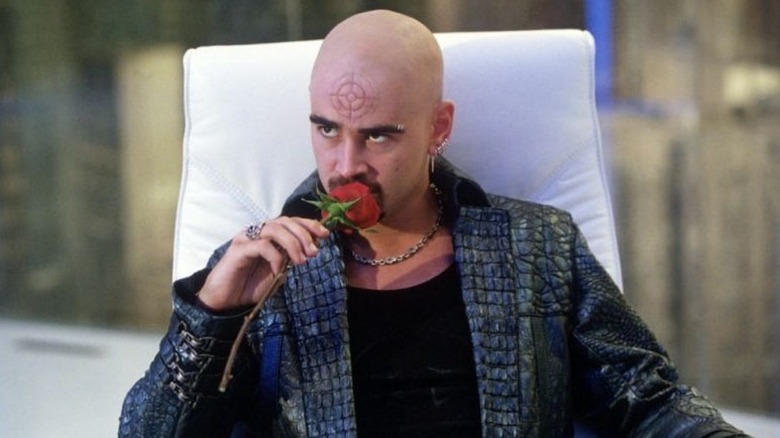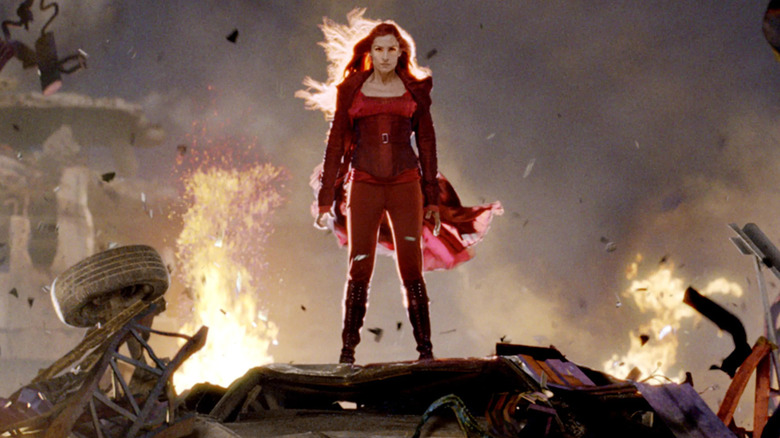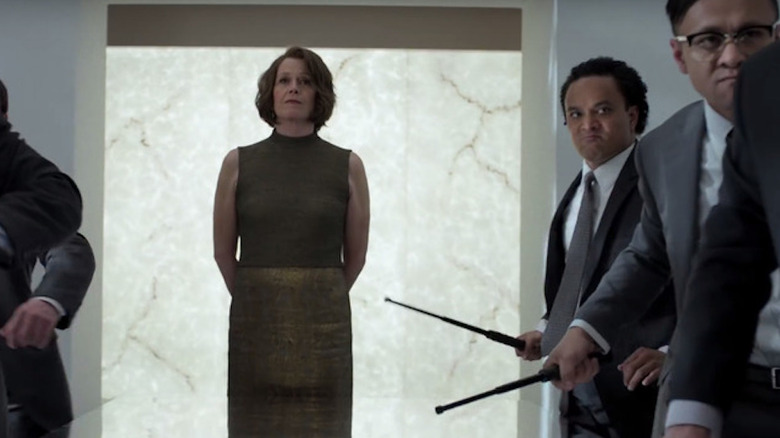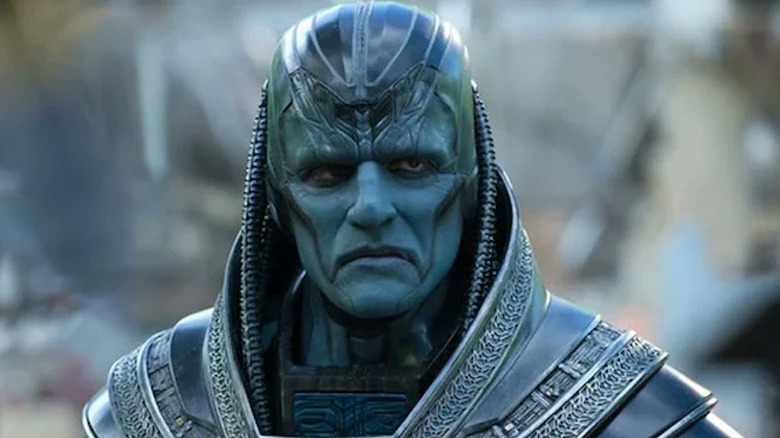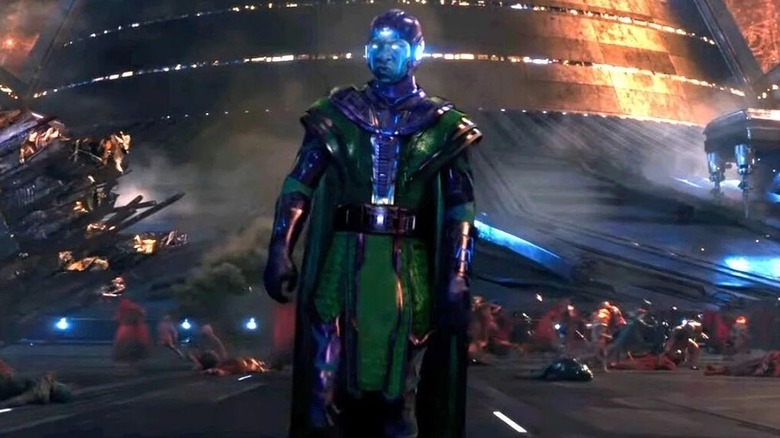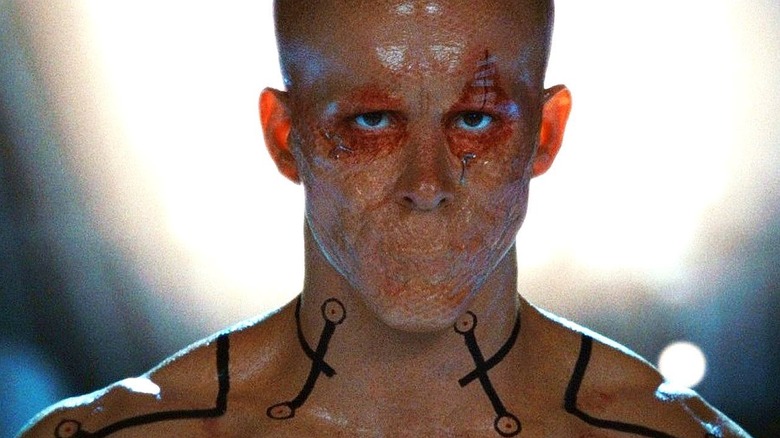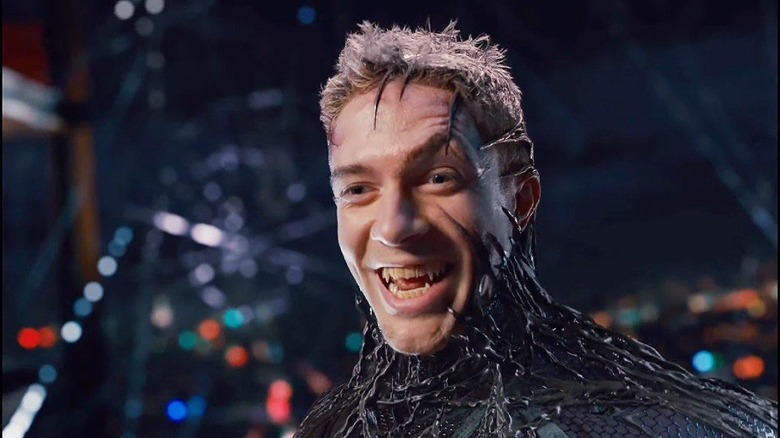Overhyped Marvel Villains That Ended Up Being Terrible
A crucial ingredient to any great superhero movie is an outstanding villain, and many of the best comic book adventures on the big screen feature antagonists even more compelling than the heroes. Adapted from iconic comics, these villains are often hyped up by both the studio's marketing efforts and fans hoping that their favorite baddies can be faithfully brought to life. The bigger the baddie, the bigger the hype.
While favorites like the Joker have been nailed more than once, and powerhouses like Thanos and Magneto have become some of the best comic book villains of all time, there are plenty who failed to deliver on the screen. All too often, Marvel in particular has botched the baddies, getting audiences excited for a major new threat to menace the likes of the Avengers or the X-Men, only to let them down with poor execution. From interstellar despots to street-level assassins, we've found the most overhyped Marvel villains who ended up being terrible.
Taskmaster
A character that can mimic the fighting style of any enemy combatant, the character of Taskmaster is a frightening adversary of the Avengers. He carries a shield like Captain America, and a bow and arrow like Hawkeye; he can swing like Spider-Man, fight like Daredevil, and has marksman skills like Bullseye. Suffice to say, he's one of the most lethal villains in the Marvel Universe who doesn't have superpowers. So audiences were right to be excited when Taskmaster was announced as a major antagonist in "Black Widow," after being ignored for some 15 years on the screen.
Played by Olga Kurlyenko, Taskmaster was gender-flipped, but otherwise was accurate in terms of the character's ability: She can copy Black Widow's moves and is shown studying and mimicking the likes of Spider-Man, Black Panther, and Captain America. Even her costume was a pretty good translation, and she wielded a shield, a bow, and a sword just like her comic book counterpart. The problem is, she played almost no role in the story, serving as a glorified henchman to main villain Dreykov (Ray Winstone) — and a silent one at that, barely uttering a word during her brief appearances in the film. Taskmaster is due to return in "Thunderbolts*," and we're hopeful the character will finally be done justice.
The Mandarin (2013)
In 2022, Marvel fans finally got to see the real Mandarin — the iconic Chinese villain from the comics who was a persistent adversary of Iron Man. Played by Tony Leung, the Mandarin appeared in "Shang-Chi and the Legend of the Ten Rings," but that's only because almost a decade earlier, the third "Iron Man" film completely wasted the villain. In "Iron Man 3," Marvel tried a little too hard to avoid the character's many racial stereotypes from the comics, ultimately leaving us all scratching our heads.
Rather than being the wielders of 10 mystical rings that grant him supernatural, almost god-like powers, the Mandarin in "Iron Man 3" is portrayed as the leader of a Middle Eastern terrorist organization. Played by Ben Kingsley, it seemed like an interesting take on the character — even if it offered up its own racial stereotypes of Arab terrorists – but it was all undermined by one of the worst twists in the Marvel Cinematic Universe.
Kingsley's version of The Mandarin turns out to be little more than a patsy: A British actor named Trevor Slattery, hired by Aldrich Killian (Guy Pearce) to be the face of his criminal empire. Despite the negative reaction, Marvel keeps bringing Slattery back, with Kingsley slated to appear heavily in the upcoming "Wonder Man" series on Disney+.
Adam Warlock
Adam Warlock is an important character on the cosmic side of the Marvel Universe. First introduced as the hero of an alternate Earth, Warlock went on to play a central role in multiple "Infinity" storylines. Nowhere to be seen in the MCU when "The Infinity Gauntlet" was adapted for the big screen, his eventual arrival was teased in the final moments of "Guardians of the Galaxy Vol. 2," which got fans seriously hyped for the sequel.
Unfortunately, due to a controversial scandal that rocked the MCU, director James Gunn's "Guardians of the Galaxy Vol. 3" was delayed by years, which had the unintended side effect of getting fans even more excited for Adam Warlock's debut, where he was played by actor Will Poulter. On screen, however, the cosmic hero was nothing like his counterpart on the page, at least not the version people really wanted to see.
Where fans wanted the foreboding, aloof, and ominous interstellar hero, what they got was an overpowered, clumsy goofball, as the character is reimagined by Gunn as an artificial man with the mind of a child. It certainly works for the movie, but as an adaptation of the character it's sorely lacking.
Baron Mordo
Stephen Strange has only a few major villains in the comics, and two of them got serious play in the 2016 film "Doctor Strange." Though Dormammu was saved for the film's finale, classic villain Baron Mordo (Chiwetel Ejiofor) is a supporting character and surprisingly, a friend rather than a foe. That all changes in the film's post-credits stinger, when we learn that Mordo — following the rise of Doctor Strange — is seeking to destroy magic users, setting him up for a major role as the antagonist in the sequel.
Fast forward to 2021: "Doctor Strange in the Multiverse of Madness" arrives and Mordo is nowhere to be found, adding the first film's ending to a long list of movie cliffhangers that were totally ignored. To be fair, Mordo does make an appearance — it's just not technically the same character, as Ejiofor plays a version of Mordo from another reality. But while the actor and the part are solid, it's not quite what fans wanted. And it seems terribly disappointing to set up a story for one of Marvel's most famous magical meanies only to entirely sideline him in what should have been his story.
Batroc the Leaper
Batroc the Leaper admittedly isn't the biggest Marvel villain or even an especially memorable one, unless you're a serious fan of Captain America from the comics. He's a somewhat goofier character in his early appearances, and did little more than kick a lot. But the character got some attention in the MCU when real-life mixed martial artist and UFC champion Georges St-Pierre played him in 2014's "Captain America: The Winter Soldier."
You won't find a more perfect casting choice, as St-Pierre is both French and a master of martial arts, and even shares his first name with the villain. So you can imagine fans' disappointment when the film was released and the character was out of the story within a few short minutes. In fact, even his lone showdown is a major letdown as Cap trounces the French mercenary with just a few quick moves. It's a solid fight sequence, but the fact that it's the end of the character's presence in the movie feels like going to a big-name boxing bout that ends in a first-round knockout. St-Pierre got a second chance in 2021's "The Falcon and the Winter Soldier," but once again the character felt sorely underutilized.
M.O.D.O.K.
Another second string villain from the "Iron Man" comics, M.O.D.O.K. is one of Marvel's strangest creations, a giant floating head with little arms and legs. He totally works in his own comedic stop-motion animated series, but is hardly the kind of weird character you'd expect to see in the MCU. That is, until the MCU went into the Quantum Realm where weirdness reigns in "Ant-Man and the Wasp: Quantumania."
For the MCU, M.O.D.O.K. was imagined a bit differently: Instead of a brilliant scientist working for A.I.M., he's Darren Cross, the villainous Yellowjacket from the first "Ant-Man" film, whose physical form is warped in the Quantum Realm. But whereas in the comics he's a tactician who has defeated some of Marvel's most powerful heroes, here he's little more than a punchline, and not even a funny one. To make matters worse, the VFX used to bring him to life are wonky at best, and like something out of an old '90s made-for-TV kids' movie at worst. Maybe someday the character will be reintroduced more effectively, but right now we're forced to wonder if he'd have been better served on the cutting room floor.
Bullseye
Daredevil is Marvel's top "street level" hero, but you might be surprised to learn that he doesn't have many well-known villains in his rogues gallery. So it was a curious decision to burn all three of DD's biggest baddies in his big screen debut, with Kingpin (Michael Clarke Duncan), Elektra (Jennifer Garner), and Bullseye (Colin Farrell) all playing major roles in the 2003 film.
One can find fault with Elektra, but it's Bullseye who gets the short straw. Played admirably by Farrell, Bullseye is reimagined as an Irish punk, with a "Matrix"-like black leather jacket and a scar shaped like a bullseye on his forehead. Despite Daredevil wearing a relatively comic-faithful bright red leather costume, Bullseye looks like he walked out of a back alley fistfight in Dublin. With so many options for a character with expert marksmanship skills, it's a curious decision to portray him as borderline clownish.
A decade later, Bullseye was rebooted for Season 3 of Netflix's "Daredevil," where he was played by Wilson Bethel, but was sadly disappointing there as well. Rather than show Bullseye at his best, we don't see him for long before he's driven insane and starts wearing Daredevil's costume. That's right — Bullseye has yet to appear on-screen in his classic outfit, but he does wear Daredevil's.
Dark Phoenix
Marvel may have missed the bullseye with Bullseye, but neither version of that character was botched quite as badly as Dark Phoenix. In the comics the Dark Phoenix — a twisted form of the hero Jean Grey — is the result of a cosmic force, with her story largely taking place away from Earth. She's among the most powerful X-Men villains and was showcased in arguably the comic's most iconic storyline. But "X-Men: The Last Stand" defanged the entire story, portraying Dark Phoenix as a brainwashed Jean Grey with souped-up psychic powers — and making her a glorified henchman of Magneto.
A disappointing interpretation, Famke Janssen's turn as Dark Phoenix in 2006 might as well have been an entirely different character; there's no mention of cosmic anything — the result of Fox's more "grounded" approach to the X-Men in the 2000s. But by 2019, superhero movies like "Guardians of the Galaxy" had featured interstellar adventures that audiences ate up like candy. So it was truly head-scratching that Fox's second attempt in the eponymously titled "Dark Phoenix" again bungled the story, setting it mostly on Earth and only hinting at the cosmic nature of her new powers rather than showing Jean (Sophie Turner) clashing with alien empires.
The real problem? While both versions of "Daredevil" were solid superhero tales, "X-Men: The Last Stand" and "Dark Phoenix" are the two worst entries in the "X-Men" film series.
The Hand
When it comes to Marvel's Netflix shows — "Daredevil," "Jessica Jones," "Luke Cage," and "Iron Fist" — there's quite a few overhyped villains we could point to. But few of them overpromised and underdelivered like the clandestine killers known as The Hand. In the comics, The Hand are Earth-616's premiere group of ninjas, appearing in "Daredevil" comics and playing a prominent role in various Wolverine stories, too.
Then came Netflix's "Defenders." Billed as an "Avengers"-like teamup of Marvel's TV heroes, the eight-part miniseries pits the combined might of Daredevil, Jessica Jones, Luke Cage, and Iron Fist against The Hand, who have diabolical plans for New York City. The only problem is, "The Defenders" paints The Hand as a mostly incompetent band of thugs that have more in common with Shredder's bumbling Foot Clan from "Teenage Mutant Ninja Turtles" — who were a parody of the Daredevil villains — than the highly skilled, battle-hardened ninjas from the comics. Their leader, Alexandra Reid (Sigourney Weaver), isn't even that scary. After all, her big plan is to ... collapse the city over the skeleton of an ancient dragon buried under Manhattan? What?
Apocalypse
If there's anything that frustrates fans of Fox's "X-Men" movies, it's how the series kept featuring Magneto as its main antagonist, rarely exploring the rest of the team's incredible array of iconic villains. Fans screamed for powerhouses like Mr. Sinister, while major characters like Juggernaut were relegated to glorified cameos. After a decade of him being ignored, however, the ancient evil called Apocalypse showed up in 2016's "X-Men: Apocalypse" — and he was met with groans before the movie was even released.
He's played by Oscar Isaac, but few blame the actor under the mask. The character, like so many other disappointing villains, was such a powerful threat in the comics that he felt as cosmically terrifying as Thanos or Kang the Conqueror. Yet the character seems almost weak in the film, with Isaac's own 5-foot-8-inch stature rarely being altered to make him seem physically imposing. His makeup, meanwhile, often makes him look like a glorified "Power Rangers" villain, something plenty of fans noticed — and mocked — when the first stills were made public.
Kang the Conqueror
Following "Avengers: Endgame," fans were anticipating the MCU's next big bad, and Kang was an obvious choice for many fans. In the comics, the time-traveling Kang has been a thorn in the side of the Avengers since the '60s. With many variants of Kang in Marvel history, he seemed like fertile ground for an MCU saga that could culminate in a massive two-part Avengers event.
Fans got their wish when rising star Jonathan Majors was cast as Kang, but when he finally appeared he wasn't what they were expecting. His first appearance was as a quirky oddball called He Who Remains in Season 1 of "Loki," while his ultimate reveal as the monstrous Kang the Conqueror came in one of the MCU's most disappointing entries, "Ant-Man and the Wasp: Quantumania." In that film, Kang is far from the imposing multiverse-conquering tyrant he is in the comics, and instead comes across as a bargain version of better villains, easily bested by the two tiny heroes.
In some ways, the saga of Majors' firing due to his troubling legal woes may have been a blessing in disguise: With audience response to Kang being an overwhelming "meh," the real-world problems did the studio a favor, forcing their hand to abandon the villain almost entirely.
Deadpool (2009)
Nobody is ever going to argue that Ryan Reynolds' Deadpool, as featured in his three films since 2016, has been anything short of uncanny in its accuracy to the source material. His costume is lifted right off the page, while Reynolds' performance is a pitch-perfect recreation of Joe Kelly's version of the character that became so popular. The same can't be said, of course, for the character's debut in "X-Men Origins: Wolverine."
One of many actors forced to play a role they hated, Reynolds reluctantly agreed to star as Wade Wilson despite not being happy with the character's portrayal in the script. And he was right: Fans were outraged when everything they loved about the character was wrong. He had no costume, he had giant blades in his forearms and shot lasers out of his eyes, while his mouth was sewn shut, taking away the snarky attitude that defines the character. Fans had been waiting years to see Deadpool on screen, but boy was that first attempt an absolute disaster.
Galactus
Often in comic book movies, more outlandish characters are given more grounded interpretations. So when Tim Story set out to adapt "The Fantastic Four" into a big-budget franchise, certain elements had to be changed. Dr. Doom, for example, was given a long fancy trench coat instead of a flowing cape. But what do you do when your villain is a giant alien in purple robot armor, with a huge "G" on his chest, who eats planets for breakfast? Well, the obvious answer is, you make him a cloud. Seriously, that's what they did. Do we really need to explain any further?
For fans of course, the reality that the Fantastic Four's most powerful foe, Galactus, wasn't at all faithful to the comics was absolutely infuriating. Comic readers had been dreaming of seeing the giant purple planet-eater for decades, so you can imagine how upsetting it was when he turned up in the 2007 sequel, "Fantastic Four: Rise of the Silver Surfer," as literally a giant cloud. It's almost too ridiculous to believe.
Venom (2007)
Sam Raimi's first two "Spider-Man" films are the gold standard of comic book movies, setting a new bar for how good they could be. Major moneymakers and critically acclaimed, they featured two of Spidey's most famous foes, the Green Goblin and Dr. Octopus. But arguably the most popular Spidey villain was saved for the threequel: The alien symbiote known as Venom. The only problem was, he had very little in common with the character from the comics, largely due to casting.
In the comics, Venom's human identity is Eddie Brock, a physically intimidating, tough-talking bodybuilder and journalist who the alien symbiote sees as a worthy host due to both his size and vicious personality. So who is the best actor to embody the qualities of this oversized, violent meathead? Of course you'd choose Topher Grace, 5-foot-11-inches and slight of build, who'd recently ended a run as a teenager on "That '70s show." Grace isn't an imposing figure and hardly the right actor to play a tough jock, so the character written for him was a whiny, petulant manchild who isn't very tough at all — the polar opposite of Brock from the comics.
